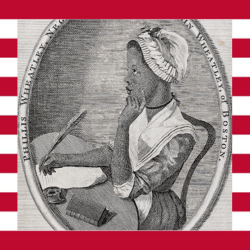
“Her poems provide a window into Black girls’ culture, slavery, and the emergence of abolitionism before and during the American Revolution. Her statue sits in Boston, Massachusetts, as a memorial to her achievements, which have been debated from her youth until today.”
Phillis Wheatley was not her name – in fact, we do not know her birth name, or even where she came from. Scholars believe she was born in what is now Senegal or Sierra Leone. Named for the ship that bore her into captivity, the Phillis, a young girl disembarked and was sold at auction in Boston Harbor in 1761.
“The ship’s manifest describes her as “being ‘of slender frame, and evidently suffering from a change of climate,’ and as having ‘no other covering than a quantity of dirty carpet about her.’” Too weak for manual labor, Phillis was sold in 1761 to John and Susanna Wheatley of Boston to be Susanna’s domestic servant and companion. Susanna soon realized Phillis was an ardent learner, and tutored her alongside the Wheatley’s children. Phillis learned English, Latin, history, geography, and the Bible. She was kept as a servant and forbidden to interact with the other slaves. Though scholars do not know why the Wheatleys educated Phillis, she soon displayed talent in writing poetry. These talents were encouraged and demonstrated to friends and family.”
Phillis’s writings are few – only a portion likely survive. Unlike most enslaved girls, Phillis was granted some freedoms, including the freedom to make friends. How this was allowed, or why, we do not know. But surviving letters indicate that Phillis knew and corresponded with Blacks in Boston and Newport, including Obour Tanner. By age thirteen, Phillis was publishing her poetry; but it is important to note that Phillis herself was not doing so; John and Susanna Wheatley dictated what was published and retained all the earnings that should have gone to Phillis. Despite her growing fame, Phillis was still enslaved.
In 1770, her “An Elegaic Poem, on the Death of the Celebrate Divine, and Eminent Servant of Jesus Christ, the Reverend and Learned George Whitefield” sparked national renown for her poetic talents. It was published in Boston, Newport, and Philadelphia newspapers and recited at Whitefield’s funeral. Over the next four years, Phillis wrote numerous poems – which the Wheatleys collected and published in London.
Phillis was allowed to travel to London for the publication, accompanied by the Wheatley’s son. While in London, Phillis toured landmarks and met famous individuals. In 1773, her book – Poems on Various Subjects, Religious and Moral – was published, and quickly spread throughout the Atlantic world. The frontispiece featured an engraving of Phillis.
Despite her fame, Phillis was enslaved. Her earnings were kept by the Wheatleys. Perhaps fortunately to some, Phillis’s fame did eventually earn her freedom: editorials in British publications led the Wheatleys to grant Phillis her freedom on March 3, 1774.
But there was a problem. They left no provision for Phillis, and it is unclear if she was granted any kind of wage for remaining with the Wheatley family. Four years later, in 1778, both John and Susanna died. Phillis was left penniless, and the Wheatley children (now adults) abandoned her.
At some point, Phillis is known to have married a free black man – John Peters – and possibly had children. As free blacks in Boston, Phillis and John led hard lives. They worked various jobs and lived in absolute poverty. John was eventually imprisoned for debts, and Phillis worked as a charwoman and scullery maid. Though it is said that Phillis continued writing, and possibly assembled a second volume of work, nothing after the 1773 book survives. She died in 1784, “uncared for and alone.”
Today, Phillis is recognized for her poetic talents – but also for the subtle politics she included in her poems. Notably, recent analysis has indicated that the language utilized in her poems sought to criticize slavery through the use of double meanings and metaphors. Of her forty-six known poems, eighteen are elegies that contain themes of black freedom as akin to death or a voyage over water – metaphors found in slave spirituals. Her life is one of the first long accounts of black girlhood in Colonial and Revolutionary America.
Quotes are from the chapter on Phillis Wheatley in “Exploring American Girlhood through 50 Historic Treasures” (Rowman & Littlefield, 2021). This blog is a copy of our Sites of Girlhood entry on Wheatley, found here.
